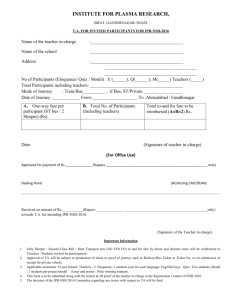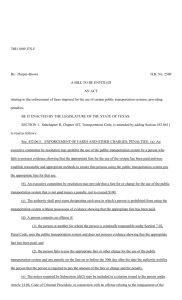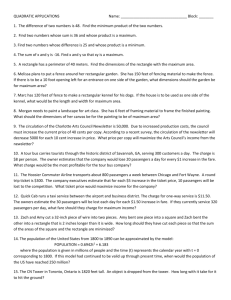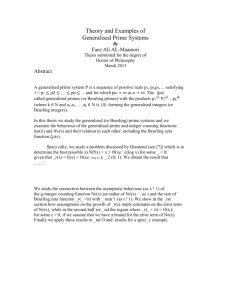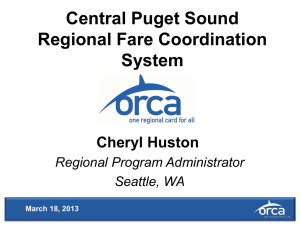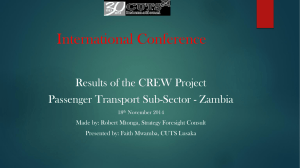The importance of travel distance
advertisement
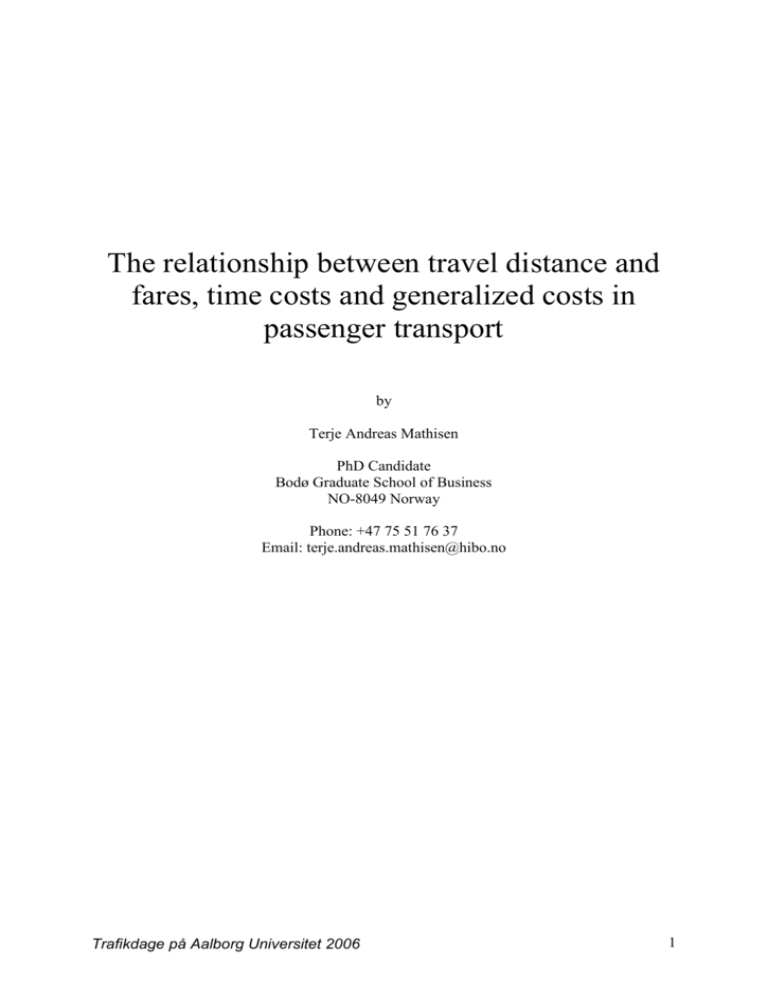
The relationship between travel distance and
fares, time costs and generalized costs in
passenger transport
by
Terje Andreas Mathisen
PhD Candidate
Bodø Graduate School of Business
NO-8049 Norway
Phone: +47 75 51 76 37
Email: terje.andreas.mathisen@hibo.no
Trafikdage på Aalborg Universitet 2006
1
Introduction
In passenger transport, the perhaps most important explanatory factor for fare level on a
journey is travel distance. This is reasonable because underlying factors such as operating
costs and demand are influenced by travel distance. For the passengers this close relationship
is regarded as fair because it implies increased fares as travelling distance increases. However,
theoretical studies considering the relationship between public transport fares, generalised
costs, fare elasticity and travel distance and how these relationships are affected by
management objectives show that fares increasing with respect to distance are not necessarily
optimal.
In addition to the monetary expenses of fares, the time related to travelling with a transport
mode has a considerable alternative pecuniary value for the passengers’. A rationale
passenger seeks to minimize the sum of monetary expenses (fares) and time costs when
travelling. Hence, a passenger would rather choose a faster and more expensive transport
mode than a cheap and slow alternative if it implies lower generalised costs for the journey.
The aim of this paper is to review empirical observations of the relationship between fares
and travel distance and subsequently, using average rates for vehicle speed and time costs,
derive the passengers’ generalised costs for air transport, bus, fast craft vessel, ferry, and rail
in Norway. A comparative analysis enables us to determine the preferred transport mode for a
given distance. Further, time costs are presented and their share of generalised journey costs
over different distances is derived for the transport modes.
The importance of travel distance
The pricing of transport services is a much studied topic. With the costs and demand
characteristics as basis, the fare scheme is designed to maximize the underlying objective
function of the company or the transport authority. Thus, it is reasonable that transport
companies set fares according to profit maximization while transport authorities maximize the
welfare of the society. Generally, the higher weight put on profit compared to consumer
surplus, the higher are the fares for any distance (Jørgensen & Preston, 2005). However, as
discussed for bus transport by Nash (1978), companies and transport authorities could
maximize other objectives than profit and social surplus. For example, Mathisen (2003)
consider goals relevant for managers such as sales and number of passengers when deriving
the relationship between fares and travel distance.
The role of travelling distance is relevant to discuss because it influences both supply and
demand through operating costs and generalised costs respectively. Jørgensen and Pedersen
(2004) present theoretical interpretations of how fares are related to travel distance and
management objectives and find an ambiguous relationship. Jørgensen and Preston (2005)
have addressed this topic using two types of objective functions and three types of demand
functions and finds that the relationship between fare and travel distance depends on the form
of the functions and is not necessarily positive.
Empirical review
The empirical experiences with respect to fares and travel distance are limited. Some studies
have focused on how operators marginal costs are influenced by travel distance in the
Trafikdage på Aalborg Universitet 2006
2
Norwegian bus industry (Jørgensen & Preston, 2003) and ferry industry (Jørgensen et al.,
2004). Based on observations of relationships between fare and travel distance, some
Norwegian studies have presented linear fare schemes; Kolstad and Solvoll (2000) for
regulated bus services, Bomstad and Mjøs (2002) for rail and regional air transport and
Mathisen (2003) for bus and air transport with low degree of regulation.
In such a comparative study, some of the underlying assumptions should be specified. First,
the observed fares are ordinary fares (not discounted) on subsidised and highly regulated
transport services. Second, some of the referred studies give quadratic and logarithmic fare
functions in addition to the linear relationship. However, the difference in variance
explanation (R2) is so marginal that with respect to practical considerations and comparability
only the linear relationships will be used. Third, some transport modes carry both goods and
vehicles in addition to passengers but this survey considers passengers only. Finally, it should
be noted that the studies are carried out at different years ranging from 2002 to 2004. The
estimated fare schemes coefficients have been adjusted to 2005 average prices using the
consumer price index (Statistics Norway, 2005) in order to ensure comparability.
The studied transport modes
Five different transport modes will be addressed, including public passenger transport by air,
rail, road and sea: 1) air transport, 2) bus, 3) fast craft vessel, 4) ferry, and 5) rail.
Air transport is operated both on commercial and subsidised basis in Norway. A
representative selection of the subsidised, and highly regulated, air transport services in the
rural areas of Norway has been studied by Bomstad and Mjøs (2002). Empirical observations
of the relationship between fare and travel distance for low regulated and commercially based
air transport are described by Mathisen (2003).
Bus services are also operated on both commercial and subsidised basis. Kolstad and Solvoll
(2000) have analysed the regulated bus services in Norway and has estimated the fare scheme
for a representative county. Mathisen and Solvoll (2004) carried out a follow up study and
estimated a fare scheme on a national basis. Although most bus services are highly regulated,
there are express buses operating inter-city services on commercial basis and able to set the
fares freely. These commercial bus services are studied by Mathisen (2003), revealing a
surprisingly strict relationship between travel distance and fares even though they are free to
set fares according to demand characteristics.
Fast craft vessels are high speed catamarans used for passenger transport in nine of the
nineteen counties of Norway. Because this transport mode mostly operates in rural areas and
requires substantial subsidies, it is regulated by the local transport authorities. Fares are
publicly available and differ between counties. Distances between ports on the other hand are
more difficult to reveal because of sailing lanes deviating from shortest distance. Still, on a
national basis there are above 200 observations giving the basis for the estimated fare scheme.
The data concern the year 2004 and was gathered for the purpose of this paper.
Ferries are vital for the transport and communication of the coastal areas of Norway. In 2004,
there where about 175 ferries serving 131 crossings and about 20 million passengers. This
transport mode operates mostly in rural areas and requires substantial subsidies. The
Norwegian Directorate of Roads regulates the ferry industry and has implemented a national
ferry fare scheme. There have been experiments with a new ferry fare scheme, which to a
Trafikdage på Aalborg Universitet 2006
3
higher degree maximises social surplus, letting passengers travel for free regardless of
distance (Solvoll & Jørgensen, 2001). Recently competition using competitive tendering
(Bråthen et al., 2004) and free ferries (Jørgensen et al., 2005) have been proposed by the new
government. Still, the basis for this paper will be the traditional national ferry fare system for
passengers in 2003 presented by the Directorate of Roads.
Rail transport is highly regulated in Norway and receives substantial subsidies from the State.
Bomstad and Mjøs (2002) have studied the pricing of services provided by the state owned
monopolist operator and estimated a fare scheme. Recently, railway transport has been
considered for privatization and exposure to competition has been initiated by the use of
competitive tendering.
Linear fare scheme estimates
Table 1 show the relationship between fare and travel distance for different transport modes in
2005 prices using OLS regression. The fare scheme gives the fare in NOK1 for a transport
mode j, Fj, at a given distance in kilometres, D. More specifically, the variable D represents
the distance the passenger experiences onboard the vehicle, whether it is by road, direct line
by air or sailing lane by sea. The R2 test indicates to which degree the variance in the fare
(dependent variable) is explained by the travel distance (independent variable). The values for
R2 in Table 1 indicate strong relationships between the independent and dependent variables
for all transport modes. It is worth noting that travel distance explains all variation in fares for
the ferries.
Table 1 - The relationship between fare and travel distance for different transport modes (2005 prices)
Transport mode
Air transport
Bus
Fast craft vessel
Ferry
Rail
Fare scheme
F1 = 269 + 5,42 ∙ D
F2 = 22 + 1,15 ∙ D
F3 = 13 + 2,19 · D
F4 = 15 + 1,12 · D
F5 = 153 + 0,91 · D
R2
0,92
0,97
0,97
1,00
0,96
The fare schemes in Table 1 indicate that linear functions, compound of a constant and a
raising coefficient, gives good approximation of the relationship between fare and travel
distance. The full fare for e.g. air transport, F1, can be interpreted as a cost for the passenger
of NOK 269 to enter the plane with an additional cost of NOK 5,42 for each kilometre
travelled. Table 1 show that air transport has both highest constant and steepest slope, while
fast craft vessel has the lowest constant and rail the flattest slope. The different fare schemes
from Table 1 are graphically illustrated in Figure 1.
Not all of the estimated fare functions in Figure 1 are valid alternatives at all distances. Based
on the distance intervals of the observed transport services it is reasonable to make restrictions
for all transport modes using three roughly divided categories, short, medium and long. On
land, bus is a valid alternative for both short and medium, rail for medium and long and air
transport on long distance only. Fast craft vessels and ferries are obviously only alternatives
in the coastal areas, but while ferries typically operate on short crossings the fast craft vessels
are an alternative also for medium distances. Air transport, which is primarily intended for
1
Currency rates at 3rd August 2006: 1 € = 7,87 NOK, 1 $ = 6,16 NOK
Trafikdage på Aalborg Universitet 2006
4
travelling over long distances, has a generally high fare level and is positioned at the upper
part of Figure 1 while bus, fast craft vessel, ferries and rail groups together at the lower part.
These fare schemes have low constants and a relatively little increase in fares with respect to
travel distance.
Figure 1 - The relationship between fare and travel distance for different transport modes
Figure 1 shows that the fares at a given travel distance differ substantially between transport
modes. One could argue that the comparison has limited practical use, since the different
transport modes are suitable for different travelling purposes. Still, for most trips two or more
of the studied alternatives are usually present in addition to the car, especially between the
larger cities. For example, public transport on the distance between the two Norwegian
coastal cities of Bergen and Stavanger (180 kms by road including a ferry service) is provided
by air, bus, fast craft vessel and rail.
Generalised journey costs
The demand for transport is explained by standard micro economic theories (e.g. Hensher &
Brewer, 2001) and behavioural models (Gunn, 2000). It is assumed that a rationale passenger
will not only consider transport against the cost of other goods but he will also choose the
transport mode which gives the lowest generalised costs (travel resistance) for the specific
travelling distance. Time has a price and alternative use and implies that passengers’ time
spent on board a vehicle could be allocated to other activities and has an alternative usage that
can be given a pecuniary value (Becker, 1965; Bruzelius, 1979).
(1)
GC a0 p ai qi
i
By relating the fare schemes in section 2 to average speed and time costs of the respective
transport mode, we are able to derive the total costs for passengers making journeys with
Trafikdage på Aalborg Universitet 2006
5
different transport modes over different distances. The total costs are defined as the
generalised journey costs in equation (1) (Balcombe et al., 2004). The generalised journey
costs, GC, are the sum of monetary costs, p, and time costs, aiqi, where ai is the value of the
time qi for time component i. Hence, the time component can be divided into a number of
sub-categories (i’s) in order to get a higher degree of detail in the analysis. In the following
analysis only time onboard the vehicle will be considered and time components as walking
and waiting will be omitted, i.e. i = {onboard}. The money costs, p, are determined by the
fare schemes given in Table 1 and time costs, aiqi are based on averaged observed values from
time travel studies.
The calculation of generalised journey costs
The generalised journey costs in this study consider the part of the trip onboard the vehicle
only. In order to consider all time costs related to a journey, passengers’ inconvenience of
waiting before and after a trip should be included. Walking and waiting is, however, not
considered to be important for the specific relationship between generalised costs and
travelling distance and is omitted in this study to improve comparability between transport
modes. In the following analyses the quality is not explicitly implemented in the model.
However, because the used time costs per hour is based on observed values and specific for
each transport mode, the quality variable is indirectly considered.
Total time costs for a trip, aiqi, is calculated by multiplying time costs per hour, ai, by total
travel time measured in hours, qi (average speed divided by distance). Average speed on a
transport mode is based on scheduled speed and compared with empirical experiences wher
available. For example, estimates of bus average speed are given in a report by Balcombe et
al. (2004) and of rail by the Norwegian National Rail Administration. Rates for passengers’
time costs per hour is based on time valuation studies collected in a handbook for cost-benefit
analysis prepared by the Norwegian Directorate of Roads (2005). The time costs for fast craft
vessel and ferry are assumed to be equal to public transport service by bus on land.
Table 2 presents the average speed for different transport modes with the corresponding
average time costs for the passengers. The handbook (Directorate of Roads, 2005) present
hourly time cost for each transport mode specifically and the variation is considerable. Some
of the differences in the observed values can be explained by different quality levels on the
transport modes and different average travel purpose for the passengers. Air has for example
higher share of business passengers than bus and thus higher average time costs. However,
this can not explain all the difference between hourly time costs on air transport compared to
other transport modes. It seems that passengers find it considerably less comfortable to spend
an hour in air than on ground. This could be reasoned by lower comfort and a general
inconvenience (or phobia) for flying.
Table 2 - Average speed and time costs (2005 prices)
Transport mode
Air transport
Bus
Fast craft vessel
Ferry
Rail
Average speed
400 km/h
25 km/h
40 km/h
20 km/h
65 km/h
Average hourly time costs
267 NOK
57 NOK
57 NOK
57 NOK
70 NOK
Trafikdage på Aalborg Universitet 2006
6
The information in Table 2 can be transformed to a linear function describing how time costs,
aiqi, increases with travelled distance, D, by multiplying the time costs per hour with the time
it takes to cover the specific distance. Subsequently, the generalised journey costs for a
transport mode can be derived by summarizing fare schemes from Table 1 and time costs
from Table 2 at any given distance. Because both fares and time costs are predicted using
travel distance and assumed to be linear, the generalised journey costs will represent a perfect
linear relationship increasing with distance and thus return an R2 value on 1.
Figure 2 illustrates the generalised journey costs for an average passenger. The transport
mode representing the lowest generalised costs is marked with bold at the lowest part of the
figure. Which transport mode is preferred depend on the distance and two intersections are
marked in Figure 2 to indicate the changes between best functions. Ceteris paribus, as marked
by intersection A, the preferred transport mode for distances below 50 kms is fast craft vessel.
Bus is the best alternative from 50 kms up to intersection B at 90 kms where rail is preferred
for longer distances. For business travellers with higher time costs the intersections are at
lower distances, and opposite for leisure travellers.
Figure 2 – Average passengers’ generalised costs for different transport modes
The generalised journey costs in Figure 2 have the same constant as the fare schemes in Table
1. This is reasonable because a trip on zero kms implies no travel time onboard the transport
mode. The raise with respect to distance in Figure 2 is the sum of the slopes of fares in Table
1 and the time costs derived from Table 2. This is the marginal generalised journey costs and
indicates an average passengers’ marginal cost for travelling one more kilometre.
The marginal generalised journey costs, representing the passengers’ marginal costs of
travelling another kilometre, is derived by differentiating the curves in Figure 2 with respect
to distance and is equal to the coefficient of the slopes. As expected, the marginal generalised
cost for travelling another kilometre is higher for business travellers than leisure travellers.
For example on ferry, which is the slowest transport mode, the passengers’ marginal costs for
Trafikdage på Aalborg Universitet 2006
7
leisure travellers is about half the value for business travellers, while they are near equal for
air transport.
Air transport and ferry are according to these calculations not the preferred transport mode for
any distances. Still, ferries are often used of necessity because they operate in areas with
difficult accessibility and are the only real alternative for many passengers. The use of air
transport despite the high generalised costs can be explained primarily by three factors. First,
the studied air transport services are full fares on services regulated by the authorities.
Travellers using discounted fares in competitive markets would be able to considerably
reduce the air transport fare level. Second, the figure is based on average hourly time values
and passengers with high time costs will find air transport more attractive because of the high
speed. Finally, air transport could simply be the only real alternative transport mode for some
trips over long distances.
The composition of generalised journey costs with respect to distance
Because the time costs increases from zero they will represent a larger share of generalised
costs as distance increases. If fares increase more than time costs with respect to distance
there will not be any point where both costs components are equal, but the time costs share of
generalised costs will increase towards an asymptote as the constant in the fare function are
being spread on more kms. Because of the linear function form, this asymptote is the marginal
time costs share of the marginal generalised journey costs.
Figure 3 – Time costs share of generalised journey costs
Figure 3 shows that the marginal time costs share of marginal generalised costs varies
considerably between transport modes and distance. The share is positively related to vehicle
speed and air transport is thus in a special position with extraordinary low time costs per
kilometre. Because air and rail has higher constants in the fare functions, their curves reach
the asymptotic value at higher distance than the other transport modes. The share indicated at
the far right of Figure 3 is the time costs approximate share of generalised costs for high
Trafikdage på Aalborg Universitet 2006
8
distances. Even though time costs make a small part of the generalised costs for air transport,
the pecuniary value is still relatively high compared to other transport modes because
distances are long and the fares are high.
Using bus as an example, the fares are larger than time costs for short distances, but time
costs are increasing more with respect to distance than fares. Figure 3 shows that the two cost
concepts are equal for bus at about 20 kms. For longer distances the time costs make the
majority (about 2/3) of the generalised journey costs. This implies that it is most important to
minimize the time costs on long-distance bus trips, e.g. by increasing quality or increasing
speed.
Concluding remarks
It is well recognized that travel distance is an important factor when determining the fare level
for public transport. Theoretically, the relationship between fares and travel distance depends
on underlying objectives and the costs- and demand functions. This paper has analysed
empirical data of the relationship between fare and travel distance for different transport
modes in Norway. Fare schemes are derived from the observations for five transport modes:
air transport, bus, fast craft vessel, ferry, and rail.
A comparison of the estimated fare schemes for the different transport modes show that air
transport has considerably higher fares than the other transport modes. As distance increases,
the fares make a relatively smaller share of the passengers generalised journey costs. Hence,
higher fares on long-distance transport modes can be reasoned by the higher quality level
required to reduce the time costs share of generalised travelling costs as fares gets less
important with respect to distance.
Presuming that all transport modes are valid alternatives on a journey, a comparison of a
passengers’ generalised journey costs can identify which transport mode is preferred for a
given distance. The calculations are based on average values for travel purpose, vehicle speed
and time costs per hour. There are two intersections when identifying the preferred transport
mode. Fast craft vessel is the preferred alternative for trips up to 50 kms followed by bus up
till about 90 kms where rail becomes the best alternative for longer distances. In practice, for
many trips several of these transport modes will not be valid alternatives and the next best
ranked transport mode will be the chosen.
The assumption of linear relationships implies that the generalised journey costs have the
same constant as the fare schemes and a raise with respect to distance which is the sum of the
slopes of fares and time costs. The marginal costs, derived by differentiating with respect to
travel distance, indicate the costs for travelling one more kilometre. The marginal generalised
journey costs for travelling one more kilometre depend on transport mode and vary from
NOK 2 to NOK 6, of which the marginal time costs share varies from 11 % by air to 72 % by
bus. These estimates rely on average speed of the transport mode and average time costs of
the passengers. Hence, the passengers’ marginal generalised journey costs will be higher 1) at
services operating at lower speeds than average and 2) for business passengers with time costs
above average.
Trafikdage på Aalborg Universitet 2006
9
Acknowledgments
I am grateful to professor Finn Jørgensen for comments on this paper.
References
Balcombe, R., Mackett, R., Paulley, N., Preston, J., Shires, J., Titheridge, H., Wardmann, M.,
& White, P. (2004). The demand for public transport: a practical guide. Report No. 593,
Transport Research Laboratory, UK.
Becker, G. S. (1965). A theory of the allocation of time. The Economic Journal, 75 (229),
493–517.
Bomstad, B. V., & Mjøs, G. S. (2002). Sammenhengen mellom reiseavstand og takst.
(Relationship between travel distance and fares). In Norwegian. Bachelor thesis. Bodø,
Bodø Graduate School of Business.
Bruzelius, N. (1979). The value of travel time: theory and measurement. London, Croom
Helm.
Bråthen, S., Fuglseth, A., Hervik, A., Larsen, O. I., Lyche, L., Odeck, J., & Sandvik, E. T.
(2004). Anbud i ferjesektoren - erfaringer og utsikter. (Tendering in the ferry industry experiences and expectations). In Norwegian. No. 0408, Molde, Norway, Møre Research.
Directorate of Roads. (2005). Konsekvensanalyser. Håndbok 140. Høringsutkast.
(Consequence analysis. Handbook 140.) In Norwegian.
Gunn, H. F. (2000). An introduction to the valuation of travel-time savings. In D. A. Hensher
& K. J. button (Eds.), Handbook of transport modelling. Elseviere Science Ltd.
Hensher, D. A., & Brewer, A. (2001). Transport: an economics and management perspective.
Oxford, Oxford University Press.
Jørgensen, F., Pedersen, H., & Solvoll, G. (2004). Ramsey pricing in practice: the case of the
Norwegian ferries. Transport Policy, 11 (3), 205–214.
Jørgensen, F., & Pedersen, P. (2004). Travel distance and optimal transport policy.
Transportation Research Part B - Methodological, 38 (5), 415–430.
Jørgensen, F., & Preston, J. (2003). Estimating bus operators' short-run, medium-term and
long-run marginal costs. International Journal of Transport Economics, XXX (1), 3–24.
Jørgensen, F., & Preston, J. (2005). The relationship between fare and travel distance - some
comments. No. 911, Transport Studies Unit, University of Oxford.
Jørgensen, F., Solvoll, G., & Welde, M. (2005). Kystdistriktene tjener på gratis ferje. (Free
ferries will benefit the coastal areas). In Norwegian. Samferdsel, 4–5.
Kolstad, P., & Solvoll, G. (2000). Nytt takstsystem for buss i Nordland. (New fare scheme for
bus in Nordland). In Norwegian. Report No. 9, Bodø, Nordland Research Institute.
Mathisen, T. A. (2003). Sammenhengen mellom takst og avstand i regulerte- og uregulerte
markeder : teori og empiri. (The relationship between fares and travel distance in high
regulated and low regulated markets: theory and empirical evidence). In Norwegian.
Master thesis. Bodø, Bodø Graduate School of Business.
Mathisen, T. A., & Solvoll, G. (2004). Busstakstene skyter i været. (Bus fares increases
dramatically). In Norwegian. Samferdsel, 43, 16–17.
Nash, C. A. (1978). Management objectives, fares and service levels in bus transport. Journal
of Transport Economics and Policy, 12 (1), 70–85.
Solvoll, G., & Jørgensen, F. (2001). Ferjetakster: takstmodell for prøvesamband. (Ferry fares:
fare scheme for trial ferry services). In Norwegian. Report No. 13, Bodø, Nordland
Research Institute.
Statistics Norway. (2005). Statistical yearbook of Norway 2005. Oslo, Statistics Norway.
Trafikdage på Aalborg Universitet 2006
10

